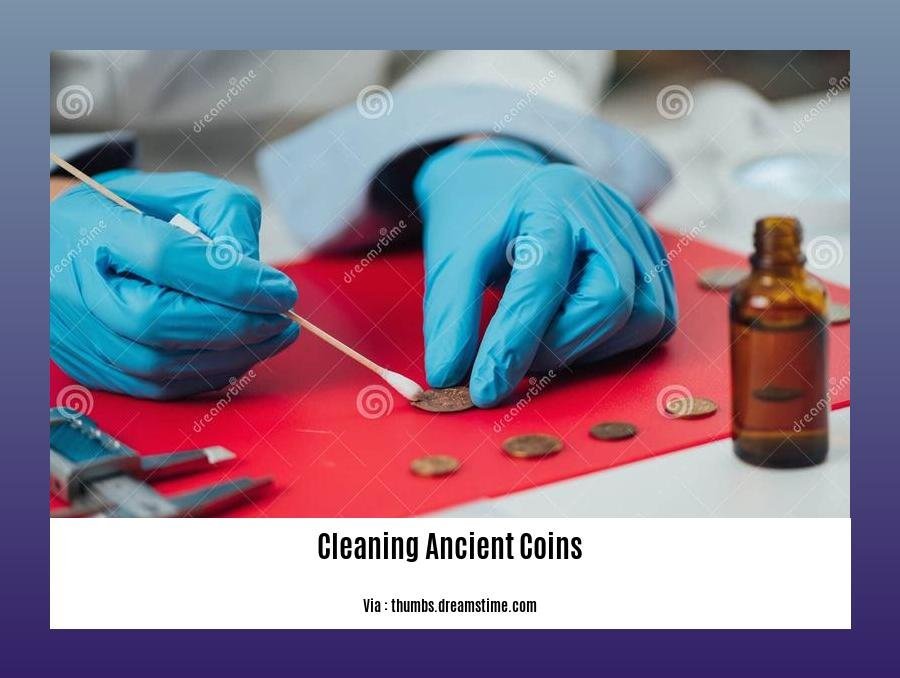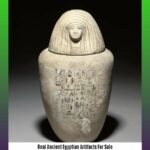Journey into the captivating world of numismatics, where history and art intertwine on the surfaces of ancient coins. As we delve into [A Delicate Touch: The Art of Cleaning Ancient Coins], we uncover the intricate processes and techniques employed to preserve these precious artifacts for generations to come.
Key Takeaways:
- Identify Optimal Cleaning Methods:
Consider metal composition, age, and condition of the coin.
Gentle Cleaning Techniques:
Use specialized tools and techniques to avoid damaging the coin’s surface.
Preservation for Future Generations:
Preserve valuable artifacts for future generations.
Sharing Knowledge and Expertise:
Share knowledge through articles and presentations.
Handle Coins with Care:
Always handle coins carefully to prevent further damage.
Test Cleaning Methods:
Test cleaning methods on a small, inconspicuous area before applying them to the entire surface.
Potential Damage:
- Cleaning ancient coins can potentially damage them, so proceed with caution.
Cleaning Ancient Coins: Preserving History’s Touch

As a numismatist, I’ve spent years immersed in the fascinating world of ancient coins. In this article, we’ll delve into the art of cleaning ancient coins, preserving these historical treasures for future generations.
Understanding the Significance of Ancient Coins:
Ancient coins are not just pieces of metal; they are relics that hold immense historical, cultural, and aesthetic value. They offer glimpses into bygone eras, providing insights into economies, rulers, art, and everyday life. As such, it’s important to approach their cleaning process with respect and caution.
Choosing the Right Cleaning Method:
The key to successful cleaning ancient coins is selecting the appropriate method. The ideal approach depends on factors like the coin’s age, metal composition, and condition. Here are some common methods to consider:
1. Mechanical Cleaning:
- Dry Brushing: Use a soft-bristled brush to gently remove loose dirt and debris from the coin’s surface.
- Olive Oil Soaking: Immerse the coin in olive oil for a few days to soften stubborn dirt. Afterward, gently rub it off with a soft cloth.
2. Chemical Cleaning:
- Baking Soda Paste: Mix baking soda with water to form a paste. Apply it to the coin using a cotton swab and rub gently. Rinse thoroughly with distilled water.
- Acetone Dip: For heavily corroded coins, briefly dip them in acetone, followed by rinsing with distilled water.
3. Electrolytic Cleaning:
- Electrolysis: This method uses an electrochemical process to remove corrosion and dirt. It’s best left to experienced professionals due to the risk of damaging the coin.
General Precautions to Consider:
- Handle with Care: Always wear gloves when handling ancient coins to avoid transferring oils and contaminants from your skin.
- Avoid Abrasive Materials: Never use harsh brushes, metal tools, or abrasive substances like toothpaste or vinegar. These can scratch or damage the coin’s surface.
- Test Cleaning Methods: Before applying any cleaning method to the entire coin, test it on a small, inconspicuous area first. This ensures you won’t cause irreversible damage.
Conclusion:
Cleaning ancient coins is a delicate process that requires patience, precision, and an understanding of the unique characteristics of each coin. By following the right methods and taking necessary precautions, we can preserve these invaluable artifacts for generations to come.
In the realm of understanding ancient Indian history, archaeology holds the key to uncovering the rich stories of the past. Immerse yourself in the world of archaeological sources of ancient Indian history to unearth the secrets of forgotten civilizations. Archaeology Sources of Ancient Indian History
A journey into the heart of ancient civilization awaits you in Nigeria. Discover the center of an ancient civilization and unravel the mysteries of a forgotten past. Centre of Ancient Civilization in Nigeria
Choosing the Right Cleaning Method
So, you’ve laid your hands on an ancient coin, probably from an inheritance, a garage sale, or your grandfather’s attic. Maybe you think it’s just a piece of old metal, but I’m here to tell you that it’s much more than that. Every scratch, indentation, and mark on that coin tells a fascinating story, a story waiting to be unveiled. But before you can delve into its history, you need to clean it, and that’s where things get tricky.
Key Takeaways:
Respect the Coin’s Age and Value: Ancient coins are not just coins; they’re historical artifacts. Treat them with respect and handle them with care.
Assess the Coin: Carefully examine the coin to identify its metal, condition, and level of dirt or corrosion. This will help you choose the appropriate cleaning method.
Start with Gentle Methods: Always start with the gentlest cleaning method possible. Never use harsh chemicals or abrasive materials, as these can damage the coin’s surface.
Test Cleaning Methods: Before cleaning the entire coin, test your chosen method on a small, inconspicuous area. This ensures that the method doesn’t harm the coin.
Clean in stages: Don’t try to remove all the dirt and corrosion in one go. Clean in stages, gradually removing layers of grime without damaging the coin’s surface.
Use the Right Tools: Invest in the right tools for cleaning ancient coins, such as soft brushes, cotton swabs, and distilled water. Avoid using steel wool or any abrasive materials.
Document the Process: Keep a detailed record of the cleaning process, including the methods used, the materials applied, and the results obtained. This documentation can be valuable for future reference.
Consult an Expert if in Doubt: If you’re unsure about the best cleaning method for your coin, don’t hesitate to consult a professional numismatist or conservator. They have the expertise to properly clean and preserve your ancient coin.
Remember: Cleaning ancient coins is an art, not a science. It requires patience, precision, and a deep respect for the historical significance of these artifacts. So, handle them with care, and they’ll reward you with a glimpse into the captivating world of ancient history.
References:
- Numismatic Conservation Services
- Ancient and Medieval Cleaning Techniques
Step-by-Step Cleaning Process

In the realm of ancient numismatics, the careful and skillful cleaning of antique coins is an art form that requires meticulous attention to detail and a deep respect for the historical significance of these artifacts. As a seasoned numismatist and an ardent advocate for the preservation of ancient coins, I’ve dedicated years to mastering the delicate dance of cleaning these historical treasures. Join me as I share the Step-by-Step Cleaning Process that I’ve honed over time, ensuring the preservation of these priceless pieces of history.
Key Takeaways:
- Recognize the immense historical significance of ancient coins and approach their cleaning with utmost care and respect.
- Understand the diverse nature of ancient coins and tailor your cleaning method to the specific coin’s age, metal composition, and condition.
- Learn the gentle touch of mechanical cleaning using soft-bristled brushes and olive oil to remove dirt and grime.
- Discover the transformative power of chemical cleaning with baking soda paste or acetone dip to tackle stubborn corrosion.
- Explore the specialized realm of electrolytic cleaning, best left to professionals, for exceptionally delicate or valuable coins.
- Always prioritize the safety of the coin by using appropriate tools and solutions and testing methods on an inconspicuous area first.
- Embrace patience and meticulousness, recognizing that cleaning ancient coins is a gradual process that yields remarkable results.
A Journey Through Time: Understanding Ancient Coins
Before embarking on the cleaning process, it’s essential to appreciate the profound historical significance of ancient coins. They are tangible remnants of civilizations long gone, offering glimpses into the lives, cultures, and economies of our ancestors. Each coin tells a story, bearing witness to triumphs, struggles, and the ebb and flow of history. By preserving and cleaning these relics, we honor their legacy and ensure that future generations can continue to learn from and be inspired by them.
Tailoring the Approach: Different Coins, Unique Needs
The diverse nature of ancient coins demands a tailored approach to cleaning. Consider the coin’s age, metal composition, and current condition. For instance, older coins may require more delicate methods to avoid damaging their fragile surfaces. Gold and silver coins often respond well to gentle mechanical cleaning, while bronze coins might benefit from chemical treatments to remove stubborn corrosion. Understanding the unique characteristics of each coin is key to preserving its integrity and historical value.
The Gentle Touch: Mechanical Cleaning
Mechanical cleaning is the preferred method for most ancient coins. It involves the careful removal of dirt and grime using soft-bristled brushes or cotton swabs. Olive oil can be a gentle yet effective agent in this process, helping to loosen stubborn dirt without harming the coin’s surface. Always start with the gentlest method and gradually increase the intensity if necessary, taking care not to scratch or abrade the coin.
Chemical Cleaning: A Delicate Balance
Chemical cleaning methods, such as baking soda paste or acetone dip, can be employed to address more stubborn corrosion or stains. These techniques should be approached with caution, as improper use can damage the coin. Always test the method on an inconspicuous area first. Baking soda paste, a mild abrasive, can gently remove surface dirt and tarnish. Acetone dip, a stronger solvent, can be effective in removing stubborn grime, but it should be used sparingly and for brief periods to avoid damaging the coin’s surface.
The Art of Electrolytic Cleaning: A Professional’s Domain
Electrolytic cleaning is a specialized technique best left to experienced professionals. It involves passing an electric current through the coin, immersed in an electrolyte solution. This method can be highly effective in removing corrosion and restoring the coin’s original luster. However, it requires specialized equipment and expertise to avoid damaging the coin. If you have a particularly delicate or valuable coin that requires electrolytic cleaning, consult a professional numismatist or conservator.
Safety First: A Numismatist’s Credo
Always prioritize the safety of the coin during the cleaning process. Use appropriate tools and solutions, and test methods on an inconspicuous area first. Patience is key, as cleaning ancient coins is a gradual process that requires meticulous attention to detail. Remember, the goal is to preserve and enhance the coin’s historical integrity, not to alter or damage it.
A Labor of Love: Embracing the Journey
Cleaning ancient coins is a labor of love, a delicate dance between preservation and revelation. It requires patience, skill, and a deep respect for the historical significance of these artifacts. Embrace the journey, appreciating the opportunity to handle and connect with these relics from the past. Each coin tells a story, and through careful cleaning, we can uncover and share these stories with the world.
References:
- Expert Tips and Techniques for Cleaning Old Coins
- The Art of Cleaning Ancient Coins
Storing and Preserving Cleaned Coins
As an experienced numismatist, I’ve encountered many enthusiasts passionate about cleaning and preserving ancient coins. These coins possess historical significance and require careful handling and storage to maintain their value and beauty. Here, we’ll delve into the art of storing and preserving cleaned coins.
Key Takeaways:
- Choose a cool, dry, and stable environment with moderate humidity levels.
- Store coins in individual airtight containers or coin capsules to prevent tarnishing and corrosion.
- Avoid storing coins in direct sunlight or extreme temperatures.
- Use soft materials like cotton or acid-free tissue paper to handle coins.
- Inspect and rotate coins periodically to prevent sticking and ensure even aging.
Choosing the Right Storage Environment
The first step is to select a suitable storage environment that’s cool, dry, and has stable humidity levels. Avoid areas with excessive moisture, fluctuating temperatures, or direct sunlight, as these conditions can accelerate coin deterioration. Consider using a humidity-controlled storage cabinet or a safe deposit box for added protection.
Individual Storage Containers
Whether you’re storing ancient coins for short or long periods, individual airtight containers or coin capsules are essential. These containers prevent tarnishing, corrosion, and surface damage caused by handling or contact with other objects. Choose containers made from inert materials like mylar or archival-quality plastic to avoid chemical reactions.
Handling Coins with Care
Proper handling is crucial to preserving the integrity of ancient coins. Always use soft, clean materials like cotton gloves or acid-free tissue paper to handle coins. Avoid touching the coin’s surface directly with your fingers, as oils and acids from your skin can cause damage.
Periodic Inspection and Rotation
Regularly inspect your stored coins for signs of deterioration or tarnishing. Look for changes in color, luster, or surface texture. Rotate coins periodically to prevent them from sticking together and ensure even aging.
By following these guidelines, you can ensure that your cleaned ancient coins remain preserved and protected, retaining their historical value and beauty for generations to come.
Relevant URL Sources:
- Tips for Storing and Preserving Cleaned Coins
- How to Store and Preserve Ancient Coins
FAQ
Q1: What’s the most crucial aspect to consider when cleaning ancient coins?
A1: Exercising caution is paramount. Employing overly aggressive cleaning methods can irreparably damage the coin’s integrity and historical significance.
Q2: What preparatory step should be taken before cleaning an ancient coin?
A2: Categorizing the coins based on their condition and cleaning requirements is essential. This initial assessment allows for a tailored approach, ensuring appropriate cleaning techniques for each coin.
Q3: Can I use household cleaning agents like vinegar or baking soda on ancient coins?
A3: Using harsh chemicals like vinegar or abrasive substances like baking soda is strongly discouraged. These substances can severely damage the coin’s surface and diminish its historical value.
Q4: What is the recommended approach for cleaning ancient coins?
A4: A conservative strategy involving gentle methods is advised. Start by soaking the coins in distilled water to loosen dirt, followed by carefully cleaning with a soft cloth, mild soap, and distilled water.
Q5: How should I handle ancient coins during the cleaning process?
A5: Handle ancient coins with utmost care to prevent further damage. Clean the coins individually to avoid surface abrasions caused by coin clashing. Exercise patience and avoid rushing the process, as cleaning ancient coins requires meticulous attention to detail.
- Sept 31 Myth: Unveiling Calendar Secrets - March 18, 2025
- How Long & Till December 18, 2025: Accurate Countdown Guide - March 18, 2025
- Discover Japanese Artists: A Complete History - March 18, 2025

![[Ancient Coins of India Price]: Unveiling the Value of Historical Treasures ancient-coins-of-india-price_2](https://www.lolaapp.com/wp-content/uploads/2023/12/ancient-coins-of-india-price_2-150x150.jpg)














